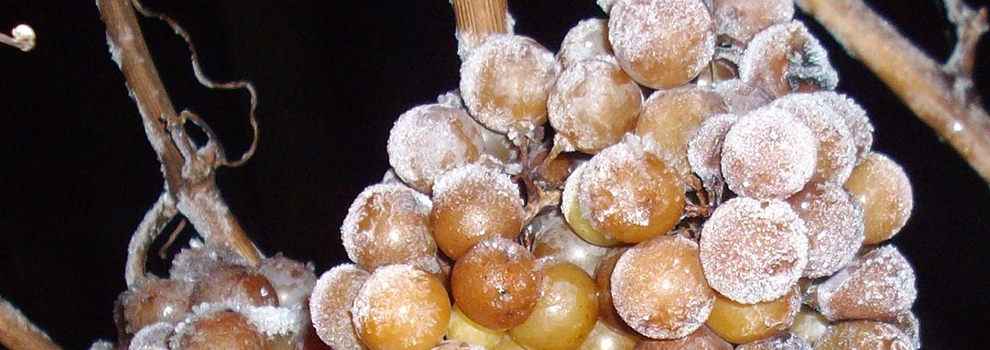
Ice wine is a sweet fragrant wine that is often drunk as a dessert wine. The best serving temperature is between 6 °C and 8 °C. Unlike most white wines, ice wine can be stored for a very long time. After-bearing develops a special character. However, ice wine can also be drunk very well young. Then it is the fresh aromas that predominate.
There are also red ice wines. In Germany these are very rare, in North America they are more common.
The grapes for this wine remain on the vines for a long time and are only picked in the winter, when they have been frozen by frost. The temperature should then not exceed −7 °C. If the night frosts do not occur early enough, the grapes can become moldy (depending on the weather conditions, there are dry autumns where the harvest is very late, without any mold formation) (the mold can be benign and malignant, by the way. Benign - pourriture noble or Edelfäule ensures for moisture loss in the grape and therefore also for highly concentrated juice, of which Beerenauslesen are usually made in Germany) and cannot be harvested to make ice wine. The price is proportional to the risks that the winegrower bears to make this wine.
The frozen grapes contain a lot of sugar, flavors and fragrances. By removing the frozen water during the pressing, a very concentrated but also sweet wine is created. Due to the high sugar content, the fermentation is difficult to start and therefore takes longer. The record sugar content for a German eiswein is 250° Oechsle, where 125° would have been legal enough.
The pressing of grapes always deserves special attention. This applies even more to ice wine. Because the yield from the grapes according to this method will be very small, people tend to press harder for more yield. The risk is that skins and seeds will give up their bitterness to the wine.
A new technique is the cryo-extraction. This technique is based on Raoult's law, which states that the higher the sugar concentration, the lower the freezing point of a liquid. In practice, the grapes are harvested at a late time and placed in a cold store (or refrigerated truck) with a temperature of −10 to −15 °C. The grapes with the least sugar freeze first and can be removed. This produces a batch of grapes with a high Oechsle content. The technique can be used in years with a lot of rain and a small chance of frost and/or noble rot in the vineyard. (this technique is not allowed in Germany, it is used - without many enthusiasts knowing it - in France, for example for Sauternes)
In Germany, the Riesling grape for Eiswein is the most favorite. (*because the most suitable: the grape ripens late and has a naturally high acidity) Canada and the United States use for their ice wine in addition to Riesling, especially the Vidal blanc.
Success is being achieved with different grape varieties in the different wine countries.
There is more and more "Ice Wine" because nowadays it is no longer seen and presented as a special feature but more as a "boutique wine", something special and striking.